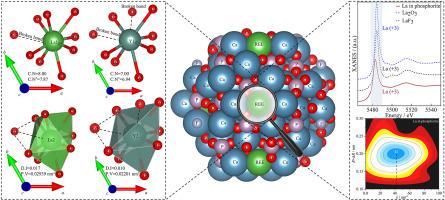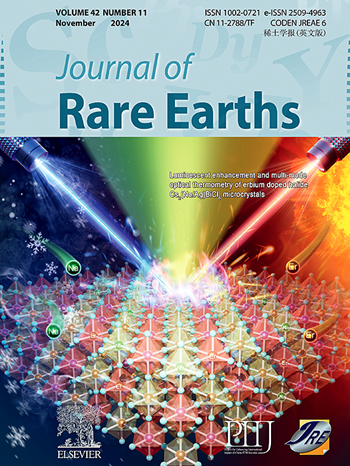Occurrence state, occupying sites and coordination structure of rare earth elements in phosphorite
IF 7.2
1区 化学
Q1 CHEMISTRY, APPLIED
引用次数: 0
Abstract
Rare earth elements (REEs) are associated with phosphorite, which is an important strategic reserve resource. During sorting process of phosphorite, REEs may move with specific host minerals, however, occurrence state and moving pattern of REEs from rock to products are still unclear, which limits separation and enrichment of REEs from phosphorite. Mappings of scanning electron microscope (SEM) and electron probe X-ray micro-analyzer (EPMA) of REEs are highly consistent with those of calcium and phosphorus, and complementary with that of magnesium, which indicates that fluorapatite (Fap) is the main host mineral of REEs. The results of flotation and leaching experiments further indicate that REEs are enriched along with Fap from phosphorite to products. Occupied sites and occupation number of REEs were obtained by X-ray diffraction (XRD) refinement based on the Rietveld method. La, Ce, Nd, and Y can occupy both Ca1 and Ca2 sites. The ratios of La, Ce, Nd, and Y at Ca2 and Ca1 sites are 4.20, 3.70, 3.00, and 1.33, showing a decreasing trend, indicating that La, Ce, and Nd tend to occupy Ca2 sites, while Y tends to occupy Ca1 sites. X-ray absorption fine structure (XAFS) shows that REEs mainly form coordinate structures with oxygen and fluorine, which is a direct evidence that REEs replace calcium(II) in phosphorite in an isomorphism form. Coordination structure and polyhedral configuration analysis indicate that substitution degree of La, Ce, Nd, and Y is Y > La > Ce ≈ Nd from easy to difficult at Ca1 and Ca2 sites. The research enriches the mineralization theory of REEs-bearing phosphorite and provides certain theoretical guidance for selective enrichment of REEs from phosphorite.

磷矿中稀土元素赋存状态、占位及配位结构
磷矿中伴生有稀土元素,是重要的战略储备资源。在磷矿分选过程中,稀土元素可能随特定的寄主矿物移动,但目前尚不清楚稀土元素从岩石到产品的赋存状态和移动模式,这限制了稀土元素从磷矿中分离富集。稀土元素的扫描电镜(SEM)和电子探针x射线微分析仪(EPMA)图谱与钙、磷图谱高度一致,与镁图谱互补,表明氟磷灰石(Fap)是稀土元素的主要寄主矿物。浮选和浸出实验结果进一步表明,稀土元素随Fap从磷矿中富集到产品中。采用Rietveld法进行x射线衍射(XRD)精化,得到稀土元素的占据位和占据数。La、Ce、Nd和Y可以同时占据Ca1和Ca2位点。La、Ce、Nd和Y在Ca2和Ca1位点的比值分别为4.20、3.70、3.00和1.33,呈下降趋势,说明La、Ce和Nd倾向于占据Ca2位点,而Y倾向于占据Ca1位点。x射线吸收精细结构(XAFS)显示稀土元素主要与氧、氟形成配位结构,这是稀土元素以同构形式取代磷矿中钙(II)的直接证据。配位结构和多面体构型分析表明,La、Ce、Nd和Y在Ca1和Ca2位点的取代度由易到难依次为Y >; La > Ce≈Nd。该研究丰富了含稀土磷矿的成矿理论,为磷矿中稀土的选择性富集提供了一定的理论指导。
本文章由计算机程序翻译,如有差异,请以英文原文为准。
求助全文
约1分钟内获得全文
求助全文
来源期刊

Journal of Rare Earths
化学-应用化学
CiteScore
8.70
自引率
14.30%
发文量
374
审稿时长
1.7 months
期刊介绍:
The Journal of Rare Earths reports studies on the 17 rare earth elements. It is a unique English-language learned journal that publishes works on various aspects of basic theory and applied science in the field of rare earths (RE). The journal accepts original high-quality original research papers and review articles with inventive content, and complete experimental data. It represents high academic standards and new progress in the RE field. Due to the advantage of abundant RE resources of China, the research on RE develops very actively, and papers on the latest progress in this field emerge every year. It is not only an important resource in which technicians publish and obtain their latest research results on RE, but also an important way of reflecting the updated progress in RE research field.
The Journal of Rare Earths covers all research and application of RE rare earths including spectroscopy, luminescence and phosphors, rare earth catalysis, magnetism and magnetic materials, advanced rare earth materials, RE chemistry & hydrometallurgy, RE metallography & pyrometallurgy, RE new materials, RE solid state physics & solid state chemistry, rare earth applications, RE analysis & test, RE geology & ore dressing, etc.
 求助内容:
求助内容: 应助结果提醒方式:
应助结果提醒方式:


